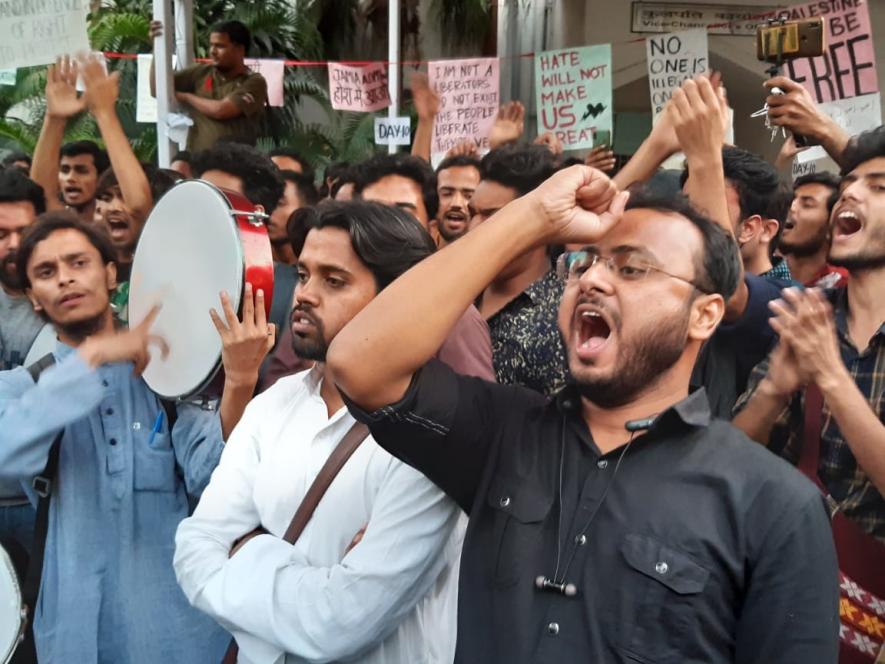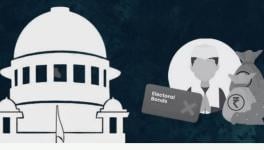Jamia Protests: How Hindu Right Dumbs Down Education

In the last few years, there has been one horrifying incident after another on the campuses. The Hyderabad Central University, Jawaharlal Nehru University, Delhi University, Allahabad University, Banaras Hindu University, Aligarh Muslim University, Lucknow University... these are just some of the prominent centres of higher education rocked by student protests. Therefore, the sheer harassment meted out to students at Jamia Millia Islamia should surprise no one.
In fact, it was the Hindu right’s intrusion into the Hyderabad Central University (HCU) that is writ large in the annals of history. The suicide of Dalit student Rohith Vemula in 2016 on the campus of HCU started a series of onslaughts on students at various universities. Each time, a different alibi was created to induce friction and tension amongst the students. Many a time, morphed and fake images were used to hound them. The torture went to the extent of slapping sedition charges against them for peacefully protesting.
An even clearer onslaught has been taking place on the syllabi and texts at schools and villages. Changing of historical facts, if not deleting entire chapters, to change the past to their liking is the bread-and-butter of the Hindu right discourse. The Rashtriya Swayamsevak Sangh or RSS-affiliated Shiksha Sanskriti Utthan Nyas (Nyas), headed by Dina Nath Batra, had sent a long list of recommendations to the National Council of Educational Research and Training (NCERT) demanding a host of changes in its textbooks.
Some of the alterations he suggested are worth examining, if only for the mirth they may have inspired in a different era: He wanted to remove English, Urdu and Arabic words from the text of a poem by the revolutionary poet Avtar Singh ‘Pash’ and a couplet by Mirza Ghalib, a poet from the 18th century. He wanted some thoughts of the poet and artist Rabindranath Tagore censored. And, predictably, he wanted extracts from the late artist MF Husain’s autobiography expunged.
Batra had also wanted to remove any reference to Mughal emperors as “benevolent”. Oddly, in his list of things to censor was any mention of the Bharatiya Janata Party (BJP) as a “Hindu” party. Then, taking another typically ahistorical stance, he wanted that the strongest regional political outfit from the former state of Jammu and Kashmir (J&K), the National Conference, should not be referred to as “secular”.
Batra’s demands bordered on the insane when he sought to delete the apology tendered by former prime minister Manmohan Singh for the 1984 anti-Sikh riots. Contradictorily, he was against a sentence in the textbooks which said that “nearly 2,000 Muslims were killed in [the] Gujarat [riots] in 2002.”
What is not very well known is that most of these demands of Nyas were fulfilled by the government. Next came other demands from various quarters: for the removal of the essay by poet-litterateur AK Ramanujan’s on Three Hundred Ramayanas: Five Examples and Three Thoughts on Translation. After the undergraduate students of the University of Delhi had been deprived of this essay, as everybody knows, it was time to demand that the American Indologist Wendy Doniger’s book, The Hindus, not be sold in India. The essay was removed from Delhi University’s reading list and Penguin India, the publishers of Doniger’s book, pulled it from circulation (though both reappeared in circulation formally or informally).
Communal elements have entered classrooms of the so called top educational institutions. Many students have told me that they are cautious not to argue on any point with the right-wing elements around them. Why, because the words “you are anti-national” practically fall out of their mouths, but this charge on a student can get him into trouble with the state, which is forever exploring the “terror angle”.
The students told me that for the members and supporters of the current establishment there are no interpretations of the Ramayana but thousands of definitions of terrorism and terrorists. The disappearance of JNU science scholar Najeeb Ahmad after he got into a fight with right wing students on campus—he is still nowhere to be found—has had a chilling effect on students everywhere I go.
The fact is, when a Muslim student has to be arrested, detained, harassed or tortured by the state, the alibis change. The charge is repeatedly and randomly issued that they are an Islamic State (ISIS) sympathiser or Al Qaeda “agents”. The charge that never fails to succeed against Muslim students, of course, is that they seek “azaadi” or freedom. The authenticity of such charges and arrests they result in is of course unknown. Are they terrorists or are they being terrorized by the state—who knows? For an ISIS “sympathiser” who decides the level of that so called “sympathy” and the authenticity of those charges? Will the arrested boys be in a condition to tell their side of the story once the state machinery is through with them?
Not to be overlooked are the violence that Kashmiri students have to face. They are humiliated if not attacked even in “top” educational institutions. Even those Kashmiri students who do not venture out of the Valley are unable to study in the country: Their classes have been disrupted for months, making the placement and job scenario dismal. They have no student unions or platform to list their grievances.
Besides, the unrest of summer 2016 on the campus of Srinagar-based National Institute of Technology (NIT) was said to have been triggered by right wing elements too. The incident provoked a large number of non-Kashmiri students to leave the campus and its hostel. The immediate reason was clashes between local Kashmiri students and outstation students over “nationalism”. What started off as a strong reaction to some Kashmiri students “celebrating” India’s loss against the West Indies in the World T20 semi-final cricket match, went beyond control because of the political environment which has primed students to fight over such issues.
Over the last few years, I have also noticed that students in Srinagar react very strongly to the killing of Palestinians by the Israeli forces. Their protests start off as peaceful but end up in blood and tears because the police fire at them. In in 2014, a major tragedy had taken place when security forces fired upon a 14-year-old student protestor in the Valley, who died on the spot. The unarmed boy’s fault—he was protesting in a non-violent way at the Israel government’s killings of Palestinians in the Gaza Settlement.
A massive outcry erupted over the student’s death but the Minister of External Affairs, Sushma Swaraj, had said that she would not like to comment on the issue or on the Israel-Palestine crisis. Not much has changed in the five years since that day. After all, in Jamia Millia Islamia students have reacted very sharply to the visit of an Israeli delegate to a seminar on campus, but the authorities are hell bent on maintaining a seemingly pro-Israeli stand. Is Israel more important than our students? Can Indians not cry out against the inhuman tactics unleashed on the Palestinians and boycott Israel?
Last week, in a notice issued to Jamia University, the Delhi Minorities Commission raised several pertinent points, including this significant one: “Apparently Jamia Millia Islamia authorities are unaware about the international Boycott, Disinvestment, Sanctions (BDS) movement in which many universities in the East and West are boycotting Israel which is occupying Palestinian lands and is subjecting Palestinians in the occupied territories to worst inhuman treatment.”
Shunning learning is easy when one is in power. All it requires is to demand that facts and documents be expunged from syllabi. What is more difficult is to learn—even basic facts.
The author is a freelance journalist and political commentator in Delhi. The views are personal.
Get the latest reports & analysis with people's perspective on Protests, movements & deep analytical videos, discussions of the current affairs in your Telegram app. Subscribe to NewsClick's Telegram channel & get Real-Time updates on stories, as they get published on our website.
























